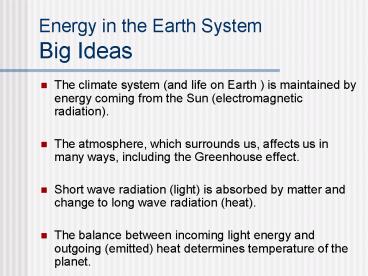Energy in the Earth System Big Ideas - PowerPoint PPT Presentation
1 / 21
Title: Energy in the Earth System Big Ideas
1
Energy in the Earth SystemBig Ideas
- The climate system (and life on Earth ) is
maintained by energy coming from the Sun
(electromagnetic radiation). - The atmosphere, which surrounds us, affects us in
many ways, including the Greenhouse effect. - Short wave radiation (light) is absorbed by
matter and change to long wave radiation (heat). - The balance between incoming light energy and
outgoing (emitted) heat determines temperature of
the planet.
2
The Greenhouse effect
- Our important Atmosphere
Adapted from the Environmental Literacy Council
Environmental Science Teacher Exchange
http//www.enviroliteracy.org/category.php?id13
3
The role of an atmosphere
- Sunlight on the Moon
- 215º F day time
- -243º F night time
- Sunlight on the Earth
- 134º F Death Valley, July
10, 1913 - -129º F Antarctica, July
21, 1983
With no atmosphere the Earths ave. temperature
would be -27 º
4
Earths Atmosphere
- Is capable of quickly moving and distributing
mass and heat over large distances. - Is an efficient communicator
- Directly affects life on Earth by supplying the
gases for the respiration of vegetation and
animals. - And by moving water from oceans to land.
5
Structure of the Atmosphere
- As you go up..
- Chemical composition changes.
- Temperature changes
- Pressure changes
- 90 of mass is in first 40 km!
6
Composition of the Atmosphere
- Nitrogen 78.1
- Oxygen 20.9
- Water vapor 0 to 4
- Argon 0.9
- Neon 0.002
- Carbon Dioxide 0.035
- Methane 0.0002
- Helium 0.0005
- Krypton 0.0001
- Nitrous oxide 0.00003
- Hydrogen 0.00005
- Ozone 0.000004
7
The energy that drives the climate system comes
from the Sun
8
(No Transcript)
9
The Sun
- Is the star located at the center of our
planetary system. - Is composed mainly of hydrogen and helium.
- Sends solar heat energy which travels through
space in the form of electromagnetic waves.
10
At the top of the atmosphere the Energy is fairly
constant
The Solar Constant 1,370 Watts/m2
11
Energy interacts with matter
- Reflection
- (albedo)
- Transmission
- Absorption
- (becomes heat)
12
What happens to solar radiation once it meets the
Earth's atmosphere?
- Energy is mainly transmitted through the
atmosphere - 30 is reflected, mainly from clouds
- Energy is absorbed by the land and water.
- Albedo how well an object reflect energy.
13
Earths Energy Budget
- Incoming energy Outgoing energy
14
The Sun and Earth give off Energy
15
Earths Energy Budget in detail
16
The Greenhouse Effect
- Short wave and visible pass easily through the
atmosphere and are absorbed by the Earths
surface. - Some energy is radiated back into the atmosphere
where it is absorbed by molecules of gas. - The heated gases radiate energy in all
directions, including back to Earth.
17
The Greenhouse gases
- Carbon Dioxide
- Methane
- Nitrous oxide
- Water vapor
- CFCs
18
Greenhouse gases
Greenhouse Gas How much it contributes Source
methane 18 Wetlands, Cattle burning, Natural gas Oceans, lakes
Carbon dioxide 49 Burning wood fuel Respiration Deforestation
Nitrous oxide 6 Car exhaust fertilizers
Chlorofluorocarbons (CFCs) 14 Refrigerants, Solvents Foamed plastic
19
The Climate System
20
Big Ideas
- The climate system (and life on Earth ) is
maintained by energy coming from the Sun
(electromagnetic radiation). - The atmosphere, which surrounds us, affects us in
a way called the Greenhouse effect. - Short wave radiation (Light) is absorbed by
matter and change to long wave radiation (heat). - The balance between incoming light energy and
outgoing (emitted) heat determines temperature of
the planet.
21
A good question.
- Why does light energy from the Sun
- pass through the greenhouse gases unabsorbed,
- but the infrared energy
- radiated from the Earth
- gets absorbed?
- Answer Resonance































